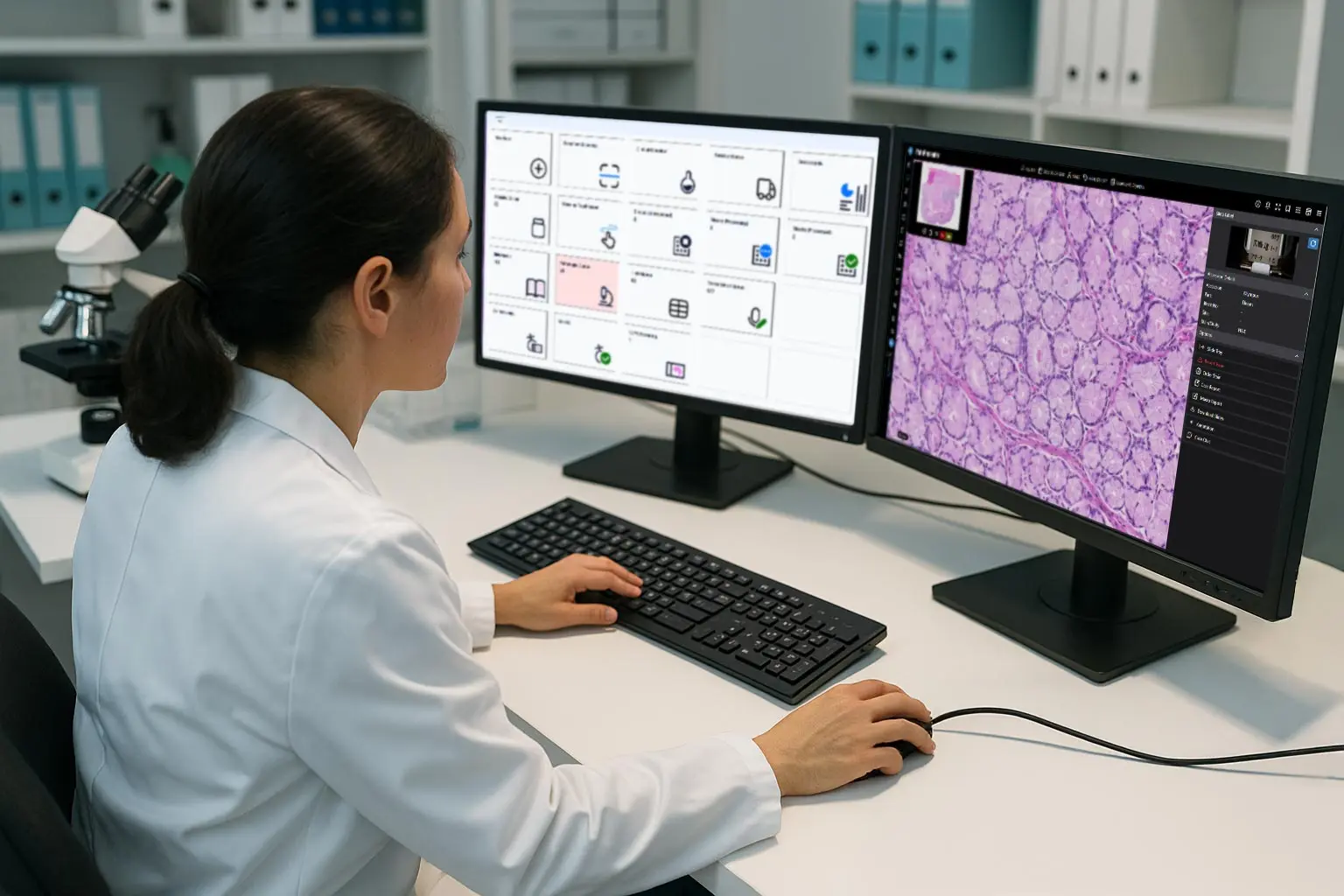Blog
A Detailed Look at How Modern Laboratory Information Systems Fully Support Quality Control
August 27, 2025
Spend time in a modern medical lab and one thing becomes abundantly clear very quickly: the critical importance of quality control (QC). It’s a foundational requirement for modern clinical labs and pathology groups, underpinning their ability to deliver accurate, reliable, and timely results to providers and patients.
Fortunately, the critical importance of quality control is also fully understood by the best laboratory information system vendors, who continue to engineer advanced LIS software capable of supporting and managing the latest and most advanced QC protocols.
Discover More: Best LIS Software - Maximize Growth With Cutting-Edge Pathology Lab Management Software
This blog post will highlight the importance of QC protocols such as the Levey-Jennings Chart and the Westgard Rules and examine how modern laboratory information system software technology fully supports them. After that, we’ll examine LigoLab’s QC module (available in the Professional Tier) and explore how it systematically tracks, monitors, and analyzes various aspects of clinical lab workflow, ensuring consistent delivery of accurate, reliable, and timely test results.
White Paper: Comparing LigoLab Informatics Platform with Legacy Laboratory Information System Software
How the Levey-Jennings Chart and the Westgard Rules Came to Be
The Levey-Jennings Chart is a visual graph that plots quality control data and shows how results deviate from the mean (the average value of a set of repeated measurements or control results). The chart makes it easier to assess whether an analytical system is functioning properly.
The L-J chart dates back to 1950 and is named after Dr. Stanley Levey and Dr. E.R. Jennings, two pathologists who first recognized that Shewhart’s individuals control chart could be effectively utilized in a clinical lab setting.
The Westgard Rules, named after Dr. James Westgard, are statistical quality control rules that date back to the 1970s and provide a structured way to determine when laboratory test results may be inaccurate due to random errors or systematic problems. Think of them as a set of checks that help clinical labs ensure test result accuracy, thereby maintaining quality and patient safety. They enable early detection of potential issues, prompt corrective action, and prevent inaccurate results from being reported.
Discover More: Top 10 Medical Laboratory Mistakes and How to Prevent Them from Happening in Your Lab

The Benefits of Comprehensive LIS Lab QC Tools and Practices
The Levey-Jennings Chart and the Westgard Rules are essential to laboratory quality control because they establish an overlapping and systematic approach to identifying errors in lab testing processes long before they impact patient results.
Here’s a summary of how they work in tandem to create a comprehensive lab QC workflow.
How the Levey-Jennings Chart and the Westgard Rules Work Together
- Visual Insight + Statistical Guidance: The Levey-Jennings Chart provides a clear visual display of QC performance over time, while the Westgard Rules supply the statistical framework needed to interpret deviations with confidence.
- Early Error Detection: Together, these QC tools enable the clinical lab to identify errors early, whether random (such as an equipment malfunction) or systematic (like reagent degradation), preventing erroneous results from being reported.
- Prevention of False Rejections: The Westgard Rules and the Levey-Jennings Chart reduce the risk of unnecessary rejections of results, ensuring that only significant deviations trigger alarms, leading to more efficient QC processes.
- Consistent Performance Monitoring: This combination ensures ongoing, real-time tracking of lab test performance, which helps labs maintain high standards and prevent problems before they affect patient results.
- Compliance with Regulations: Both tools help labs meet the quality control standards required by regulatory bodies and accrediting agencies, ensuring compliance and proper documentation.
Best Practices and Tools for Maintaining High QC Standards
In addition to using the Levey-Jennings Chart and the Westgard Rules, clinical laboratories can proactively improve quality control by implementing a variety of best practices, including the following:
Regular Calibration and Maintenance of Equipment - Regular calibration and maintenance are essential for ensuring accurate results and reducing the risk of malfunctions. Calibration aligns instruments with standard values, while maintenance optimally promotes functionality, helping to minimize errors in test results.
Internal Quality Control (IQC) Programs - IQC programs involve running control materials, which provide an ongoing measure of accuracy and help identify potential issues early on.
External Quality Assessment (EQA) / Proficiency Testing - By participating in EQA programs, laboratories compare their test results against those of other labs, providing an external measure of accuracy. If performance falls short, corrective actions can be taken to improve methods and maintain consistency. EQA programs thus help ensure that laboratories remain in line with industry standards and can consistently provide reliable patient results.
Standard Operating Procedures (SOPs) - These documents address every aspect of testing, quality control, and troubleshooting, ensuring that all personnel adhere to standardized protocols.
Staff Training and Competency Assessment - Regular training and competency assessments further contribute to quality control by ensuring that staff are up-to-date with current best practices, techniques, and regulatory requirements. Competency checks help verify that laboratory staff have the skills to perform their duties accurately and efficiently.
Data Management Systems - Laboratory information systems and laboratory information management systems (LIMS) play key roles in tracking samples and managing quality control data. Advanced laboratory software systems can automate data collection, making it easier to monitor trends and analyze QC data. This allows labs to identify and address potential problems. Additionally, electronic QC logs within these laboratory software systems improve data storage, trend identification, and organization, ensuring efficient quality control management.
Key elements of laboratory quality control also include root cause analysis, method validation, statistical QC software, and reagent management. Root cause analysis, in particular, helps uncover the source of QC failures so corrective and preventive actions can be implemented. Validation of new test methods ensures they meet performance standards, while quality control software helps labs monitor real-time data. Proper management of reagents and supplies is also essential for minimizing errors.
Clinical laboratories can achieve even greater reliability and consistency in their testing processes by incorporating these additional quality control measures in correlation with the Levey-Jennings Chart and the Westgard Rules.
Discover More: Laboratory Information Systems (LIS vs LIMS) for Data Management

How Advanced LIS Systems Support QC
Modern laboratory information systems were briefly referenced earlier in this blog, so let’s next look at detailed examples of how the best LIS software supports the highest levels of lab QC.
One of the main ways advanced LIS systems support quality control is through automated tracking of QC data. By directly collecting and recording quality control results from laboratory instruments, these LIS systems reduce the risk of manual errors and improve the accuracy of data management. This automation also frees up time for lab personnel, allowing them to focus more on analyzing results and less on manual data entry.
Another significant feature of modern LIS systems is real-time monitoring and alerting functionality. The best LIS software can be configured to notify laboratory personnel immediately if quality control results fall outside of acceptable limits or if a Westgard rule violation occurs. These real-time alerts enable prompt investigation and corrective action, preventing the release of potentially inaccurate patient results. This proactive approach to quality control helps ensure that any issues are identified and resolved quickly, safeguarding the reliability of patient testing.
As touched on earlier, modern medical LIS software also includes built-in tools for statistical quality control (SQC) analysis (such as generating the Levey-Jennings Chart and applying the Westgard Rules) and performing trend analysis. These features enable laboratory staff to assess QC data systematically and identify issues such as shifts or trends that may indicate underlying problems. The ability to visualize QC data through charts and graphs makes it easier to spot inconsistencies, ensuring that laboratory tests remain accurate and reliable.
Document management and integration of standard operating procedures (SOPs) are further ways in which the best LIS software enhances quality control. SOPs can be stored within the LIS system, allowing staff easy access to procedures and protocols. This promotes consistency in laboratory operations, as personnel can follow standardized workflows directly from the medical LIS. Additionally, the LIS lab software can store calibration records, QC logs, and other important documentation, simplifying compliance with regulatory standards and audit requirements.
Participating in External Quality Assessment (EQA) programs is crucial for maintaining laboratory accuracy, and LIS systems make it easier to manage this process. Advanced LIS medical solutions can store EQA results, generate comparison reports, and monitor the lab’s performance against other laboratories. By centralizing EQA management, these modern LIS healthcare solutions enable laboratories to identify areas for improvement and ensure that they consistently meet external quality standards.
Trend analysis and historical data review are other key benefits provided by modern pathology LIS systems, enabling users to store and analyze historical QC data to detect long-term trends, monitor instrument stability, and evaluate reagent performance. By analyzing trends, laboratories can identify gradual changes and take preventive measures before problems escalate. This long-term monitoring capability, combined with other features such as instrument calibration alerts and audit trails for compliance, makes advanced LIS systems indispensable for ensuring high-quality control standards in clinical laboratories.
Discover More: Essential Anatomic Pathology LIS Software Features to Optimize Laboratory Workflow

A Closer Look at LigoLab’s Powerful and Comprehensive Quality Control Module
As a leading provider of advanced pathology lab software (such as LIS systems, laboratory billing solutions, and direct-to-consumer lab testing portals) for two decades, LigoLab has gained a well-earned reputation for enabling its lab partners to modernize operations.
LigoLab’s QC module serves as a great example of this. It doesn’t just track a lab's performance - it actively enhances it by systematically monitoring, analyzing, and optimizing various workflow aspects and ensuring consistent delivery of precise and trustworthy results.
At its core, LigoLab’s QC module enables users to configure test-specific rules and track outcomes in real time. It extends beyond standard metrics by integrating Allowable Total Error (ATE) and Biological Variance. ATE captures both analytical and preanalytical errors, offering a more complete view of overall performance, while Biological Variance reflects natural fluctuations in patient results, providing deeper insight into lab assessments.
The QC module truly excels when handling large volumes of complex clinical tests. It minimizes errors and boosts efficiency by leveraging industry-standard methods while ensuring a thorough analysis of testing processes and providing actionable insights to refine a lab's testing accuracy.
Embedded within the LigoLab Medical LIS & Lab RCM Informatics Platform, the QC module delivers full workflow transparency, detecting problematic samples early and preventing errors from slipping through the process.
Discover More: Why Integrated LIS System and Lab RCM Software is a Catalyst for Growth
On the compliance front, LigoLab's QC module simplifies the often daunting process of meeting regulatory requirements. It effortlessly generates detailed, audit-ready reports that satisfy CAP, CLIA, and other agency standards. Plus, all QC data is securely archived for easy access during inspections.
In essence, LigoLab's QC module is more than just a pathology lab reporting software tool - it's a strategic asset that elevates a lab’s quality, streamlines efficiency, and ensures full compliance.
Ready to Learn More?
We invite you to learn more about the QC module (bundled into the Professional Pricing Tier) and LigoLab’s commitment to innovation by contacting a knowledgeable LIS software product specialist.






